Higher Water Yield but No Evidence of Higher Flashiness in Tropical Montane Cloud Forest (TMCF) Headwater Streams
Abstract
1. Introduction
2. Study Area
3. Methodology
4. Results
4.1. General Statistics from Data
4.2. Comparison with GLMs
4.2.1. Storm-Event Runoff
4.2.2. Flashiness
4.2.3. Duration of Stormflow
4.2.4. Baseflow
5. Discussion
6. Conclusions
- Storm-event water yield was up to 169% higher in the TMCF compared to the TLRF. This is attributed to higher moisture in the TMCF.
- The TMCF had 6.6x higher peak discharge than the TLRF, but it took up to 77% longer to reach peak discharge. Additionally, it took 55% longer for the stream in the TMCF to respond to rainfall input. Time-to-peak was significantly influenced by rainfall intensity and antecedent rainfall (API15); stream response time towards rainfall was significantly influenced by rainfall intensity. Catchment dimensions and topography may overrule the influence of rainfall, moisture, gradient, and soil type.
- Antecedent precipitation (API20, API 10, and API 7) directly correlated to baseflow and affected catchment moisture conditions, which in-turn governed the duration of stormflow—storms in the TMCF lasted 11% longer than in the TLRF. The only hydrograph characteristic that was directly controlled by antecedent precipitation was the time-to-peak, but there was no significant difference in time-to-peak between the TMCF and the TLRF.
Author Contributions
Funding
Data Availability Statement
Acknowledgments
Conflicts of Interest
Appendix A
| Hydro. Component | Metric. | Descrip. Stats. | From Data | |
| TLRF | TMCF | |||
| Runoff | Qtot | Sum | 306.71 | 825.99 |
| (mm) | Mean | 4.2 | 9.08 | |
| Max | 40.63 | 143.93 | ||
| Min | 0.03 | 0.1 | ||
| Qstorm | Sum | 117.99 | 568.43 | |
| (mm) | Mean | 1.62 | 6.25 | |
| Max | 18.14 | 126.97 | ||
| Min | 0 | 0.01 | ||
| Responsiveness | Qpeak | Sum | 9.6 | 90.64 |
| (mm 10min−1) | Mean | 0.13 | 1 | |
| Max | 1.18 | 23.74 | ||
| Min | 0 | 0.01 | ||
| Tres | Sum | 1700 | 7350 | |
| (mins) | Mean | 23 | 81 | |
| Max | 470 | 570 | ||
| Min | 0 | 0 | ||
| Tpeak | Sum | 6580 | 15,710 | |
| (mins) | Mean | 90 | 173 | |
| Max | 810 | 2060 | ||
| Min | 20 | 30 | ||
| Baseflow | Qinitial | Sum | 1.921 | 3.039 |
| (mm 10min−1) | Mean | 0.026 | 0.033 | |
| Max | 0.095 | 0.239 | ||
| Min | 0.002 | 0.007 | ||
| Qbase | Sum | 190.64 | 260.59 | |
| (mm) | Mean | 2.61 | 2.86 | |
| Max | 22.53 | 16.97 | ||
| Min | 0.03 | 0.1 | ||
| Storm duration | Tstorm | Sum | 56,090 | 84,370 |
| (mins) | Mean | 768 | 927 | |
| Max | 4700 | 12,160 | ||
| Min | 40 | 50 | ||
References
- Bidin, K.; Douglas, I.; Greer, T. Dynamic response of subsurface water levels in a zero- order tropical rainforest basin, Sabah, Malaysia. In Hydrology of Warm Humid Regions: Proceedings of an International Symposium Held at Yokohama, Japan, 13–15 July 1993; IAHS Publication: Wallingford, UK, 1993; pp. 491–496. [Google Scholar]
- Chappell, N.A.; Tych, W.; Chotai, A.; Bidin, K.; Sinun, W.; Chiew, T.H. BARUMODEL: Combined data based mechanistic models of runoff response in a managed rainforest catchment. For. Ecol. Manag. 2006, 224, 58–80. [Google Scholar] [CrossRef]
- Mohamad, N.A.; Annammala, K.V.; Jamal, M.H.; Yusop, Z.; Sugumaran, D.; Nainar, A. Accelerated soil erosion in cultivated highlands in Tropics: In situ measurement using laser erosion bridge method. J. Water Clim. Chang. 2019; in press. [Google Scholar]
- Annammala, K.V.; Mohamad, N.A.; Sugumaran, D.; Masilamani, L.S.; Liang, Y.Q.; Jamal, M.H.; Yusop, Z.; Yusoff, A.R.M.; Nainar, A. Sediment clues in flood mitigation: The key to determining the origin, transport, and degree of heavy metal contamination. Hydrol. Res. 2021, 52, 91–106. [Google Scholar] [CrossRef]
- Douglas, I.; Spencer, T.; Greer, T.; Bidin, K.; Sinun, W.; Meng, W.W. The impact of selective commercial logging on stream hydrology, chemistry and sediment loads in the Ulu Segama rain forest, Sabah, Malaysia. Philos. Trans. R. Soc. B 1992, 335, 397–406. [Google Scholar]
- Sammori, T.; Yusop, Z.; Kasran, B.; Noguchi, S.; Tani, M. Suspended solids discharge from a small forested basin in the humid tropics. Hydrol. Process. 2004, 18, 721–738. [Google Scholar] [CrossRef]
- Zuecco, G.; Penna, D.; Borga, M.; van Meerveld, H.J. A versatile index to characterize hysteresis between hydrological variables at the runoff event timescale. Hydrol. Process. 2016, 30, 1449–1466. [Google Scholar] [CrossRef]
- Ziegler, A.D.; Benner, S.G.; Tantasirin, C.; Wood, S.H.; Sutherland, R.A.; Sidle, R.C.; Jachowski, N.; Nullet, M.A.; Xi, L.X.; Snidvongs, A.; et al. Turbidity-based sediment monitoring in northern Thailand: Hysteresis, variability, and uncertainty. J. Hydrol. 2014, 519, 2020–2039. [Google Scholar] [CrossRef]
- Aich, V.; Zimmermann, A.; Elsenbeer, H. Quantification and interpretation of suspended-sediment discharge hysteresis patterns: How much data do we need? Catena 2014, 122, 120–129. [Google Scholar] [CrossRef]
- Nainar, A.; Bidin, K.; Walsh, R.P.D.; Ewers, R.M.; Reynolds, G. Variations in suspended sediment yield and dynamics in catchments of differing land-use in Sabah. Trans. Sci. Technol. 2015, 2, 1–19. [Google Scholar]
- Nainar, A.; Bidin, K.; Walsh, R.P.D.; Ewers, R.M.; Reynolds, G. Effects of different land-use on suspended sediment dynamics in Sabah (Malaysian Borneo)—A view at the event and annual timescales. Hydrol. Res. Lett. 2017, 11, 79–84. [Google Scholar] [CrossRef]
- Shamsuddin, S.A.; Yusop, Z.; Noguchi, S. Influence of plantation establishment on discharge characteristics in a small catchment of tropical forest. Int. J. For. Res. 2014, 2014, 408409. [Google Scholar] [CrossRef]
- Nainar, A.; Tanaka, N.; Bidin, K.; Annammala, K.V.; Ewers, R.M.; Reynolds, G.; Walsh, R.P.D. Hydrological dynamics of tropical streams on a gradient of land-use disturbance and recovery: A multi-catchment experiment. J. Hydrol. 2018, 566, 581–594. [Google Scholar] [CrossRef]
- Muñoz-Villers, L.E.; McDonnell, J.J. Runoff generation in a steep, tropical montane cloud forest catchment on permeable volcanic substrate. Water Resour. Res. 2012, 48, 1–17. [Google Scholar] [CrossRef]
- Ramírez, B.H.; Teuling, A.J.; Ganzeveld, L.; Hegger, Z.; Leemans, R. Tropical Montane Cloud Forests: Hydrometeorological variability in three neighbouring catchments with different forest cover. J. Hydrol. 2017, 552, 151–167. [Google Scholar] [CrossRef]
- Mahali, M.; Kuraji, K.; Kamlun, K.U.; Bidin, K.; Nainar, A.; Repin, R.; Gunsalam, G.; Cleophas, F. Rainfall Characteristics in a Tropical Montane Cloud Forest, Gunung Alab, Crocker Range Park, Sabah, Malaysia. Trans. Sci. Technol. 2020, 7, 80–89. [Google Scholar]
- López-Ramírez, S.M.; Sáenz, L.; Mayer, A.; Muñoz-Villers, L.E.; Asbjornsen, H.; Berry, Z.C.; Looker, N.; Manson, R.; Gómez-Aguilar, L.R. Land use change effects on catchment streamflow response in a humid tropical montane cloud forest region, central Veracruz, Mexico. Hydrol. Process. 2020, 34, 3555–3570. [Google Scholar] [CrossRef]
- Tanaka, N.; Nainar, A.; Sato, T.; Kuraji, K. Decline in catchment evapotranspiration due to forest maturity: Another evidence from a Japanese catchment. In Geophysical Research Abstracts; Copernicus Publications: Vienna, Austria, 2019. [Google Scholar]
- Noz-Villers, L.E.M.; Mcdonnell, J.J. Land use change effects on runoff generation in a humid tropical montane cloud forest region. Hydrol. Earth Syst. Sci.-Discuss. 2013, 10, 5269–5314. [Google Scholar] [CrossRef]
- Jarvis, A.; Mulligan, M. The climate of cloud forests. Trop. Mont. Cloud For. Sci. Conserv. Manag. 2011, 343, 39–56. [Google Scholar] [CrossRef]
- Clark, K.E.; Torres, M.A.; West, A.J.; Hilton, R.G.; New, M.; Horwath, A.B.; Fisher, J.B.; Rapp, J.M.; Robles Caceres, A.; Malhi, Y. The hydrological regime of a forested tropical Andean catchment. Hydrol. Earth Syst. Sci. 2014, 18, 5377–5397. [Google Scholar] [CrossRef]
- Zadroga, F. The hidrological importance of a montane cloud forest area of Costa Rica. In Tropical Agricultural Hydrology. Watershed Management and Land Use; Lal, R., Ed.; Wiley: Hoboken, NJ, USA, 1981; pp. 59–73. ISBN 0471279315. [Google Scholar]
- Bruijnzeel, L.A.; Mulligan, M.; Scatena, F.N. Hydrometeorology of tropical montane cloud forests: Emerging patterns. Hydrol. Process. 2011, 25, 465–498. [Google Scholar] [CrossRef]
- Muñoz-Villers, L.E.; Mcdonnell, J.J. Interactive comment on “Land use change effects on runoff generation in a humid tropical montane cloud forest region”. Hydrol. Earth Syst. Sci. 2013, 10, 2369–2371. [Google Scholar]
- Muñoz-Villers, L.E.; McDonnell, J.J. Land use change effects on runoff generation in a humid tropical montane cloud forest region. Hydrol. Earth Syst. Sci. 2013, 17, 3543–3560. [Google Scholar] [CrossRef]
- Sabah Parks The Official Sabah Parks Website—Crocker Range Park. Available online: https://www.sabahparks.org.my/crocker-range-park (accessed on 31 August 2022).
- Directorate of Overseas Survey The Soils of Sabah, Kota Kinabalu, Soils Sheet (NB 50-10). Ordnance Survey. 2010. Available online: https://esdac.jrc.ec.europa.eu/images/Eudasm/Asia/images/maps/download/MY3007_5SO.jpg (accessed on 16 September 2022).
- Mojiol, A.R.I. Ecological Landuse Planning and Sustainable Management of Urban and Sub-Urban Green Areas in Kota Kinabalu, Malaysia; Cuvillier Verlag: Göttingen, Germany, 2006. [Google Scholar]
- Town and Regional Planning Department, S. Sabah Coastal Zone Profile 1998—3 CLIMATE (Part I). Available online: http://www.townplanning.sabah.gov.my/iczm/reports/Coastal (accessed on 7 November 2021).
- Nainar, A.; Majuakim, L.; Kuraji, K.; Justine, V.T.; Repin, R.; Lakim, M.; Hassan, R.; Mahali, M. Inobong Experimental Catchment (IEC). In Experimental Watershed and Weather Stations in Asian University Forests Consortium; Tanaka, N., Im, S., Lai, Y.-J., Tantasirin, C., Mahali, M., Zhang, H., Suryatmojo, H., Chandrathilake, T., Eds.; The University of Tokyo Forests Press: Tokyo, Japan, 2022; ISBN 4903321290. [Google Scholar]
- Nainar, A.; Majuakim, L.; Kuraji, K.; Justine, V.T.; Repin, R.; Lakim, M.; Hassan, R.; Mahali, M. Gunung Alab Experimental Catchment (GAEC). In Experimental Watershed and Weather Stations in Asian University Forests Consortium; Tanaka, N., Im, S., Lai, Y.-J., Tantasirin, C., Mahali, M., Zhang, H., Suryatmojo, H., Chandrathilake, T., Eds.; The University of Tokyo Forests Press: Tokyo, Japan, 2022; ISBN 4903321290. [Google Scholar]
- Permanent Research Plot Committee. Inobong Vegetation Survey; Unpublished data.
- Permanent Research Plot Committee. Vegetation Survey (Alab); Unpublished data; 2010. [Google Scholar]
- Repin, R.; Majuakim, L.; Suleiman, M.; Nilus, R.; Mujih, H.; Gunsalam, G. Checklist of trees in Crocker Range Park Permanent Research Plot, Sabah, Malaysia. J. Trop. Biol. Conserv. 2012, 9, 127–141. [Google Scholar]
- Nainar, A.; Tanaka, N.; Sato, T.; Mizuuchi, Y.; Kuraji, K. A comparison of hydrological characteristics between a cypress and mixed-broadleaf forest: Implication on water resource and floods. J. Hydrol. 2021, 595, 125679. [Google Scholar] [CrossRef]
- Nainar, A.; Kishimoto, K.; Takahashi, K.; Gomyo, M.; Kuraji, K. How Do Ground Litter and Canopy Regulate Surface Runoff?—A Paired-Plot Investigation after 80 Years of Broadleaf Forest Regeneration. Water 2021, 13, 1205. [Google Scholar] [CrossRef]
- Salinas, N.; Cosio, E.G.; Silman, M.; Meir, P.; Nottingham, A.T.; Roman-Cuesta, R.M.; Malhi, Y. Tropical Montane Forests in a Changing Environment. Front. Plant Sci. 2021, 12, 712748. [Google Scholar] [CrossRef]
- Tobón, C.; Bruijnzeel, L.A. Near-surface water fluxes and their controls in a sloping heterogeneously layered volcanic soil beneath a supra-wet tropical montane cloud forest (NW Costa Rica). Hydrol. Process. 2021, 35, e14426. [Google Scholar] [CrossRef]
- Fahey, T.J.; Sherman, R.E.; Tanner, E.V.J. Tropical montane cloud forest: Environmental drivers of vegetation structure and ecosystem function. J. Trop. Ecol. 2016, 32, 355–367. [Google Scholar] [CrossRef]
- Singh, N.K.; Emanuel, R.E.; McGlynn, B.L.; Miniat, C.F. Soil Moisture Responses to Rainfall: Implications for Runoff Generation. Water Resour. Res. 2021, 57, e2020WR028827. [Google Scholar] [CrossRef]
- Tao, Z.; Li, M.; Si, B.; Pratt, D. Rainfall intensity affects runoff responses in a semi-arid catchment. Hydrol. Process. 2021, 35, e14100. [Google Scholar] [CrossRef]
- Shaban, A.; Khawlie, M.; Abdallah, C.; Awad, M. Hydrological and watershed characteristics of the El-Kabir River, North Lebanon. Lakes Reserv. Res. Manag. 2005, 10, 93–101. [Google Scholar] [CrossRef]
- Nainar, A.; Tanaka, N.; Sato, T.; Kishimoto, K.; Kuraji, K. A comparison of the baseflow recession constant (K) between a Japanese cypress and mixed-broadleaf forest via six estimation methods. Sustain. Water Resour. Manag. 2021, 7, 1–13. [Google Scholar] [CrossRef]
- Nainar, A.; Tanaka, N.; Sato, T.; Kuraji, K. Comparing Runoff Characteristics between an Evergreen Cypress Forest and a Mixed-Broadleaf Forest during Different Phenological Periods in Central Japan; Copernicus Publications: Vienna, Austria, 2019; Volume 21, pp. 2019–4671. [Google Scholar]
- Zhang, X.; Hu, M.; Guo, X.; Yang, H.; Zhang, Z.; Zhang, K. Effects of topographic factors on runoff and soil loss in Southwest China. CATENA 2018, 160, 394–402. [Google Scholar] [CrossRef]
- Bonhomme, V.; Frelat, R.; Gaucherel, C. Application of elliptical Fourier analysis to watershed boundaries: A case study in Haiti. Géomorphologie Relief Processus Environ. 2013, 19, 17–26. [Google Scholar] [CrossRef]
- Guo, Y.; Liu, S.; Baetz, B.W. Probabilistic rainfall-runoff transformation considering both infiltration and saturation excess runoff generation processes. Water Resour. Res. 2012, 48, 1–17. [Google Scholar] [CrossRef]
- Stewart, R.D.; Bhaskar, A.S.; Parolari, A.J.; Herrmann, D.L.; Jian, J.; Schifman, L.A.; Shuster, W.D. An analytical approach to ascertain saturation-excess versus infiltration-excess overland flow in urban and reference landscapes. Hydrol. Process. 2019, 33, 3349–3363. [Google Scholar] [CrossRef]
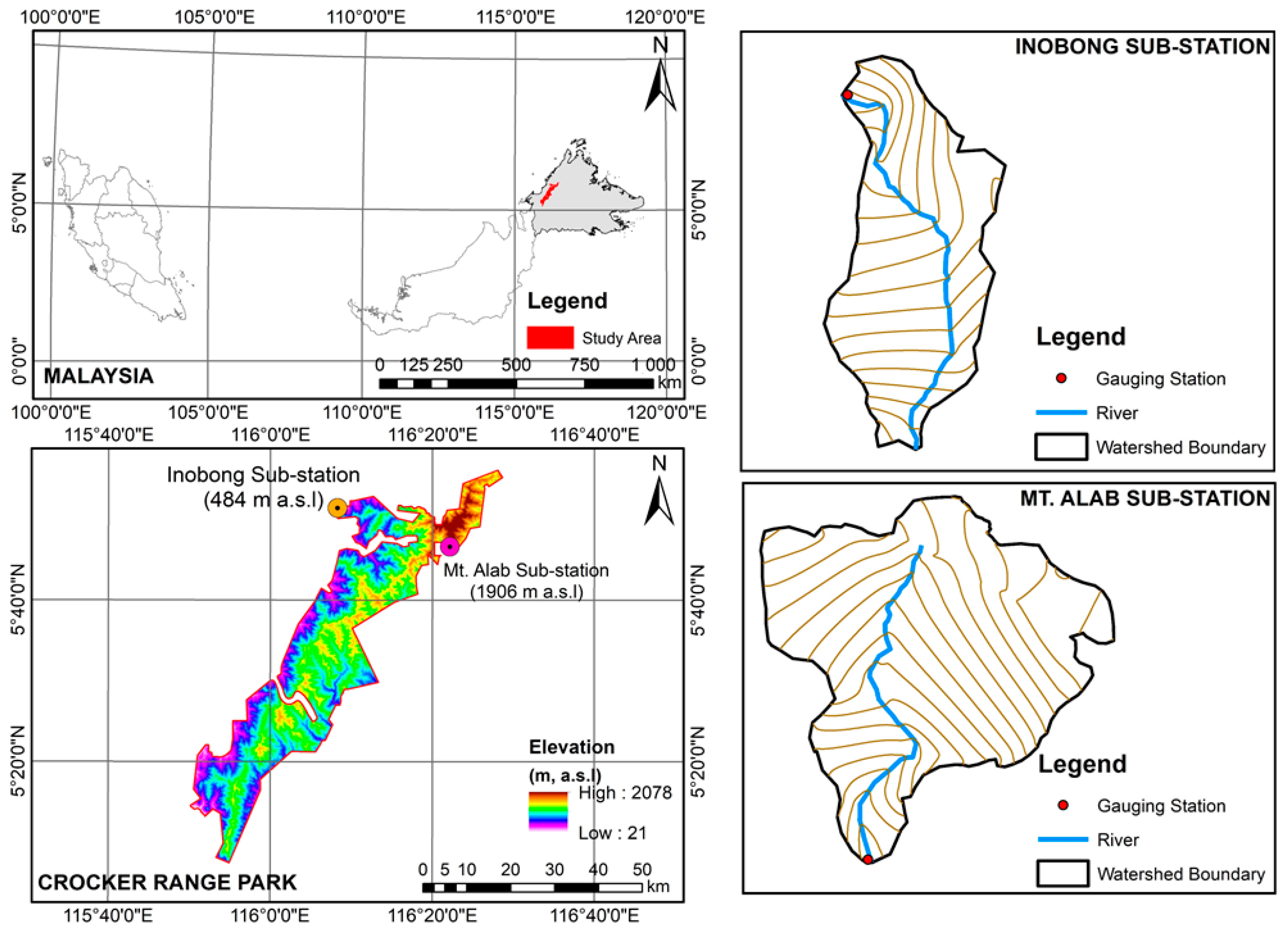
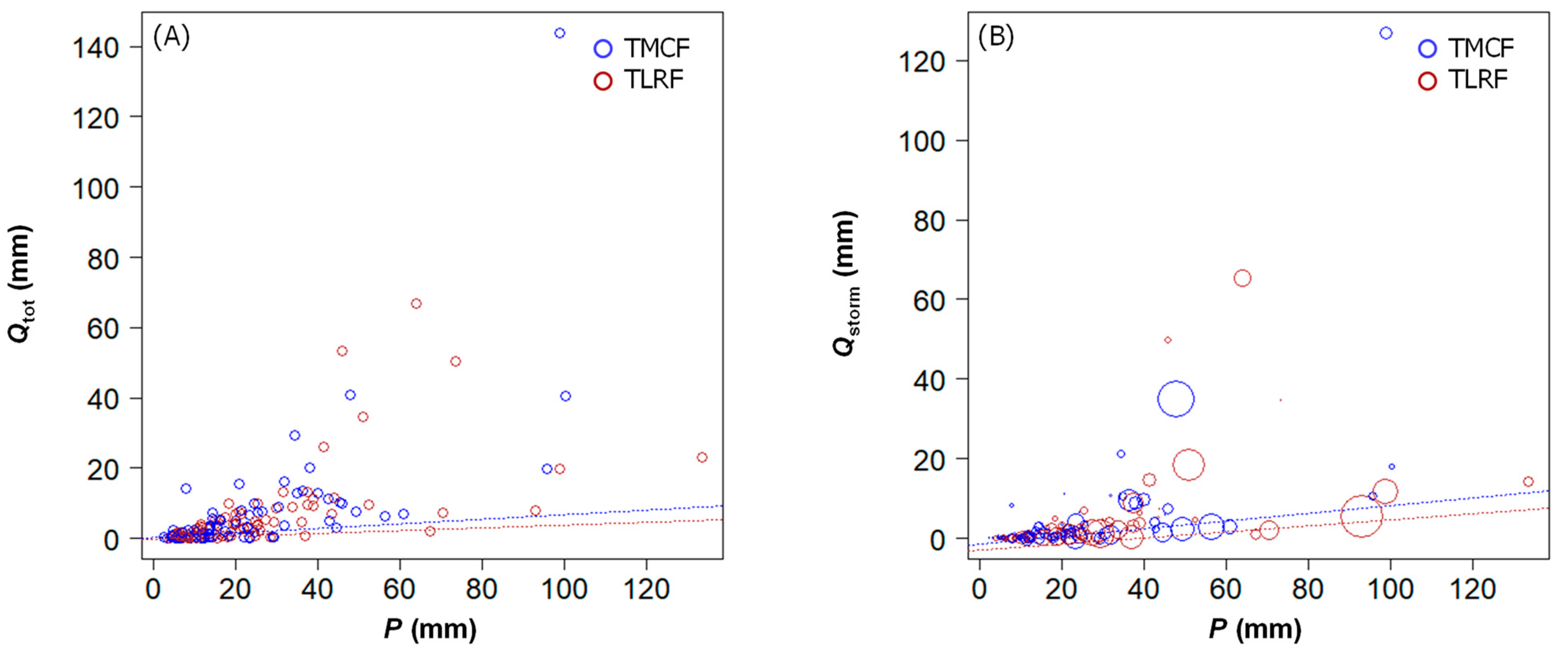
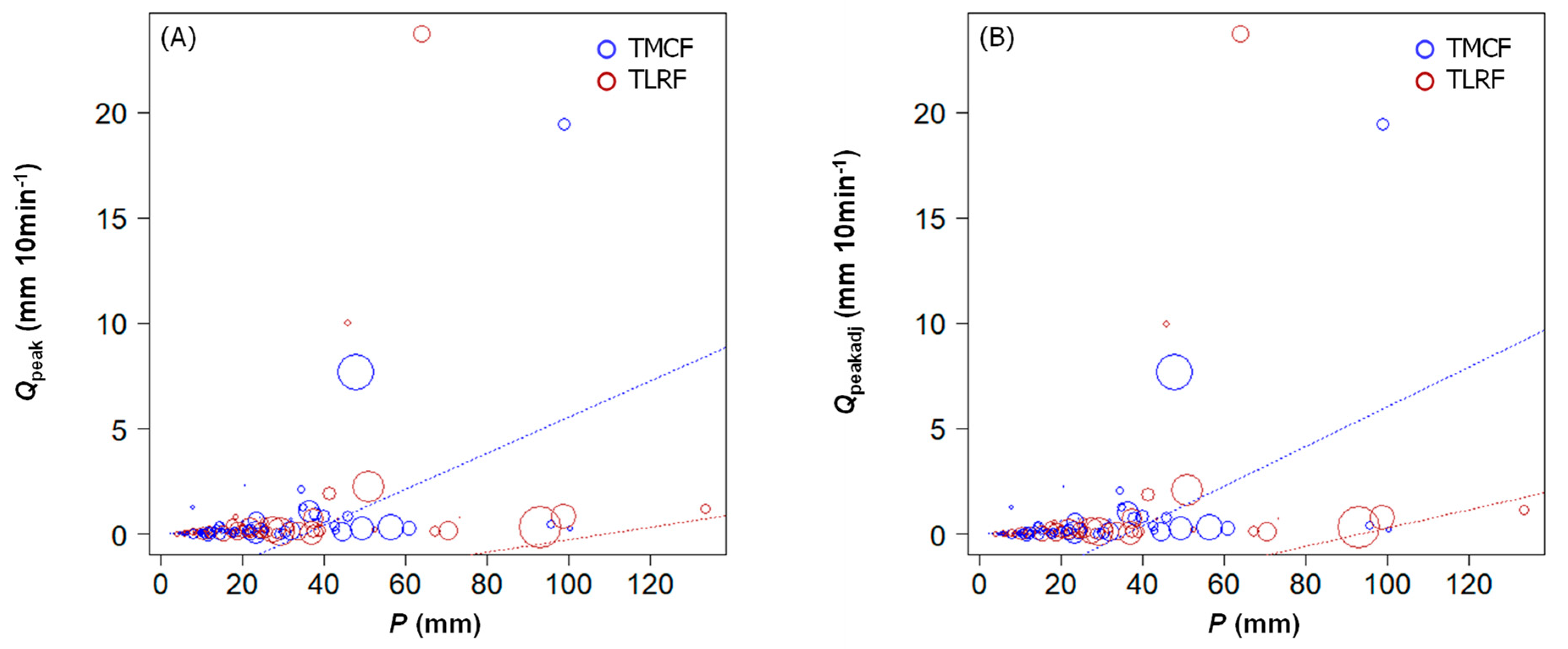
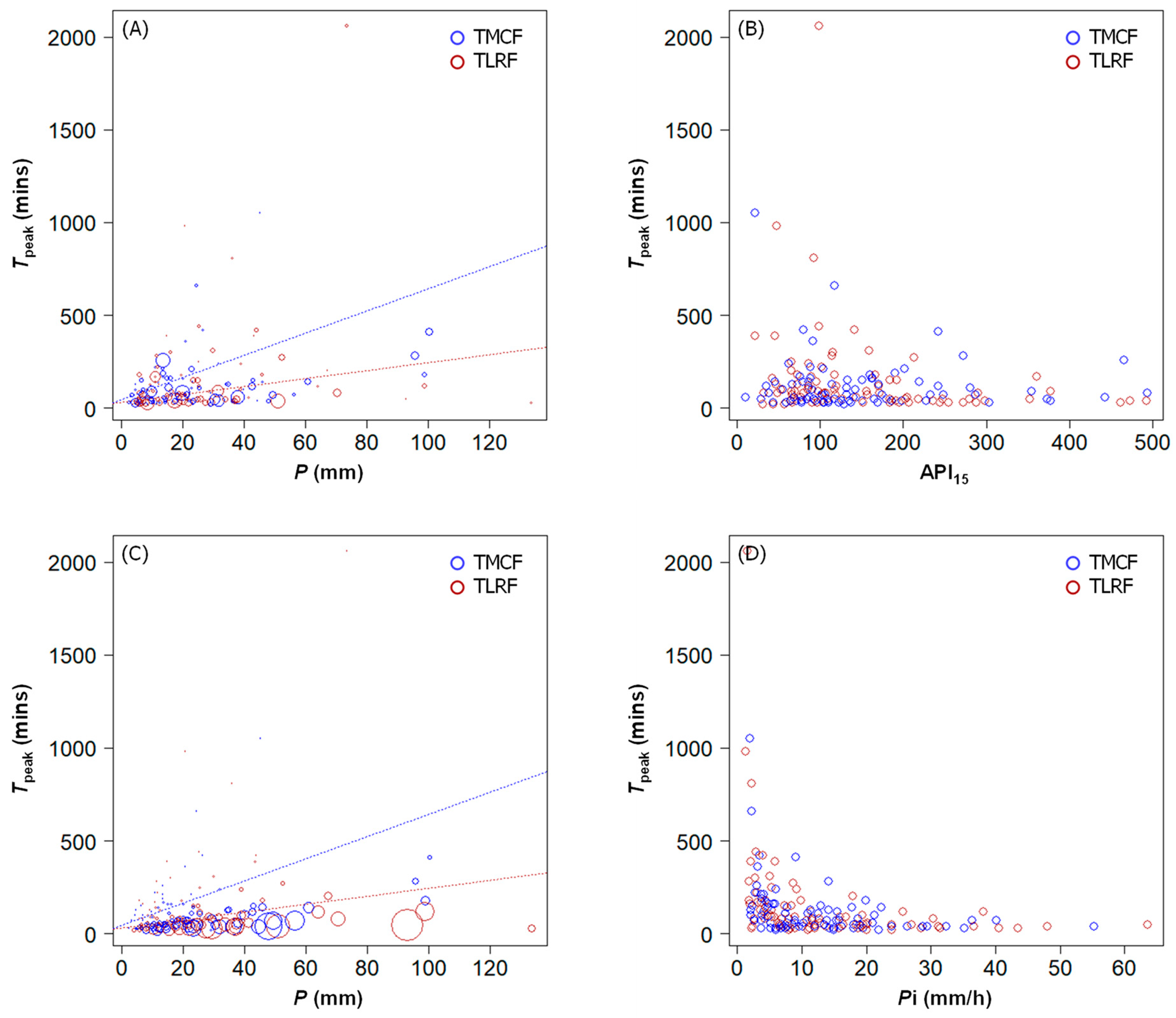
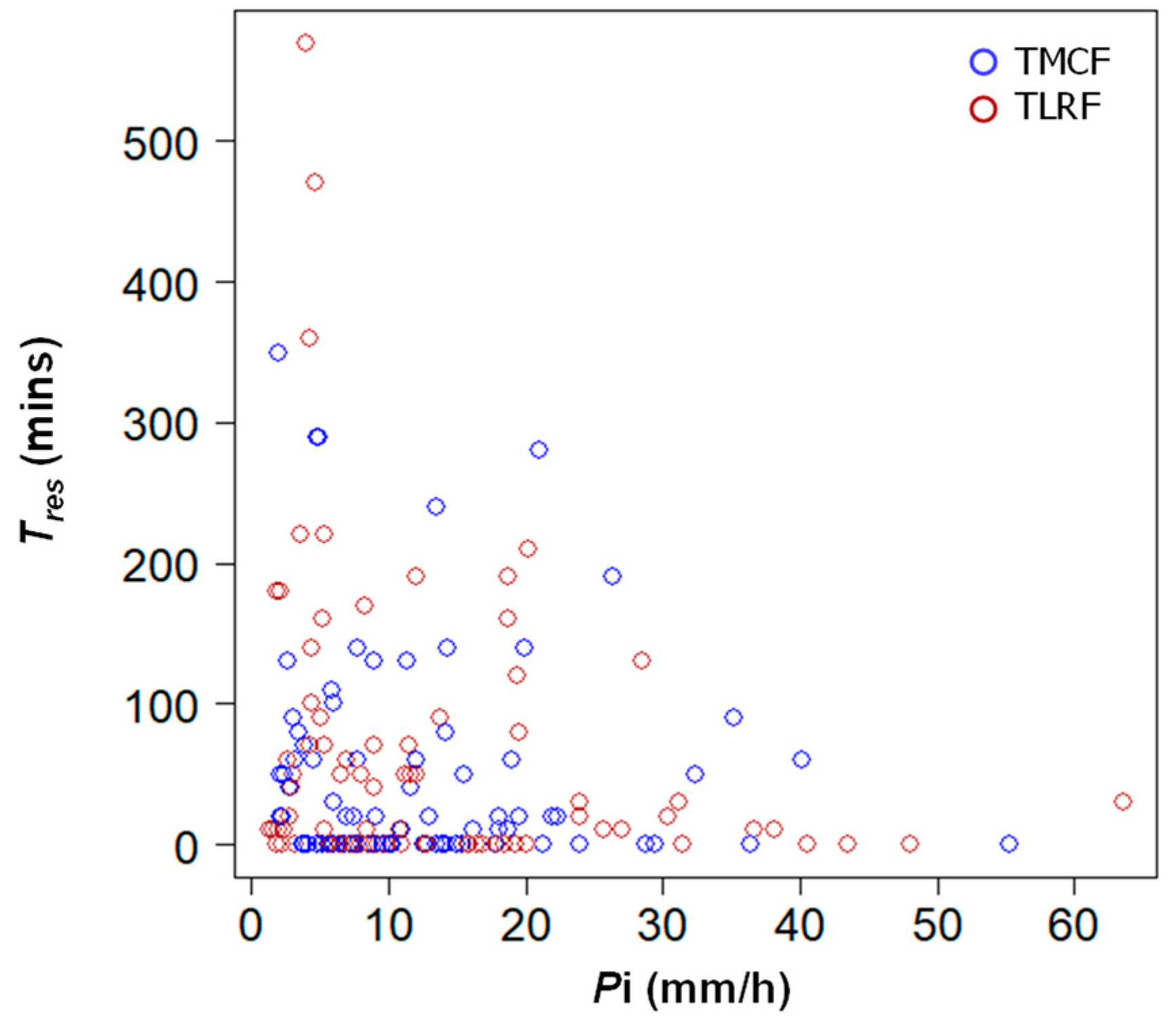
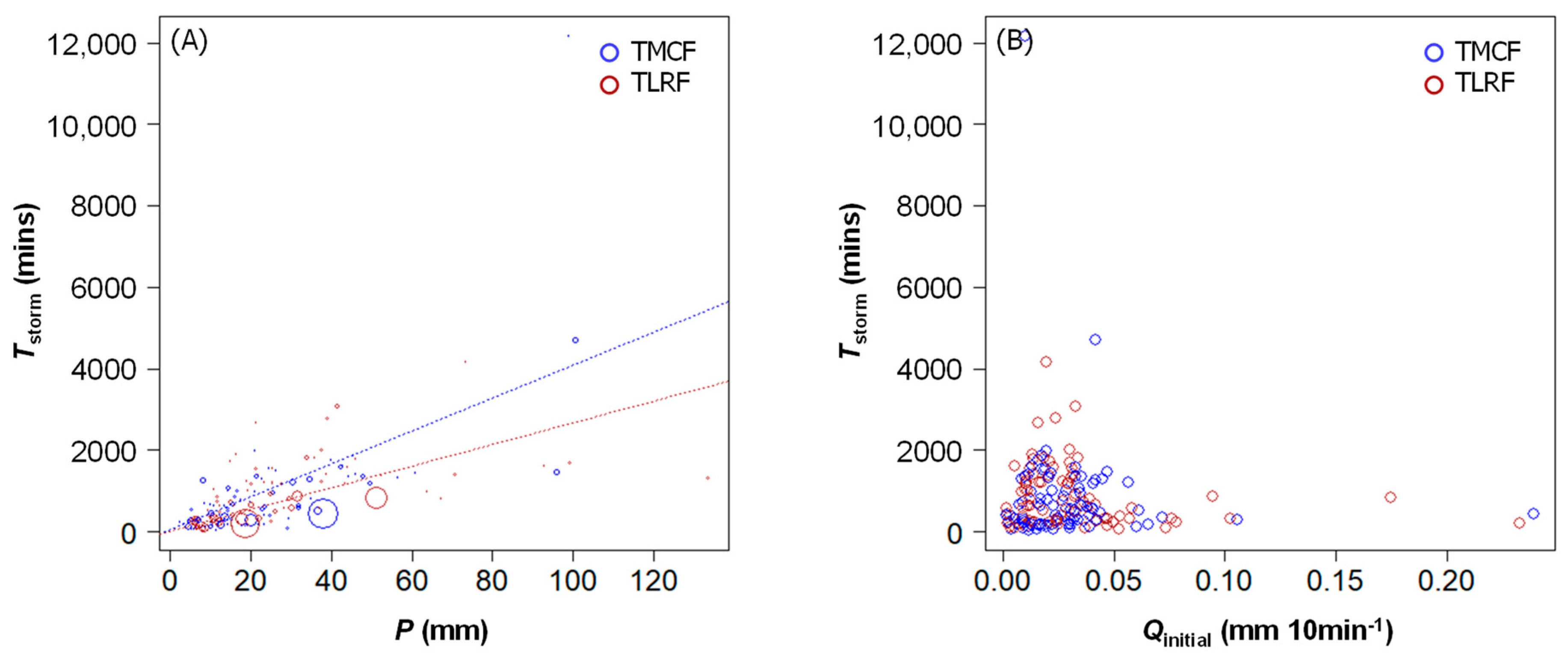
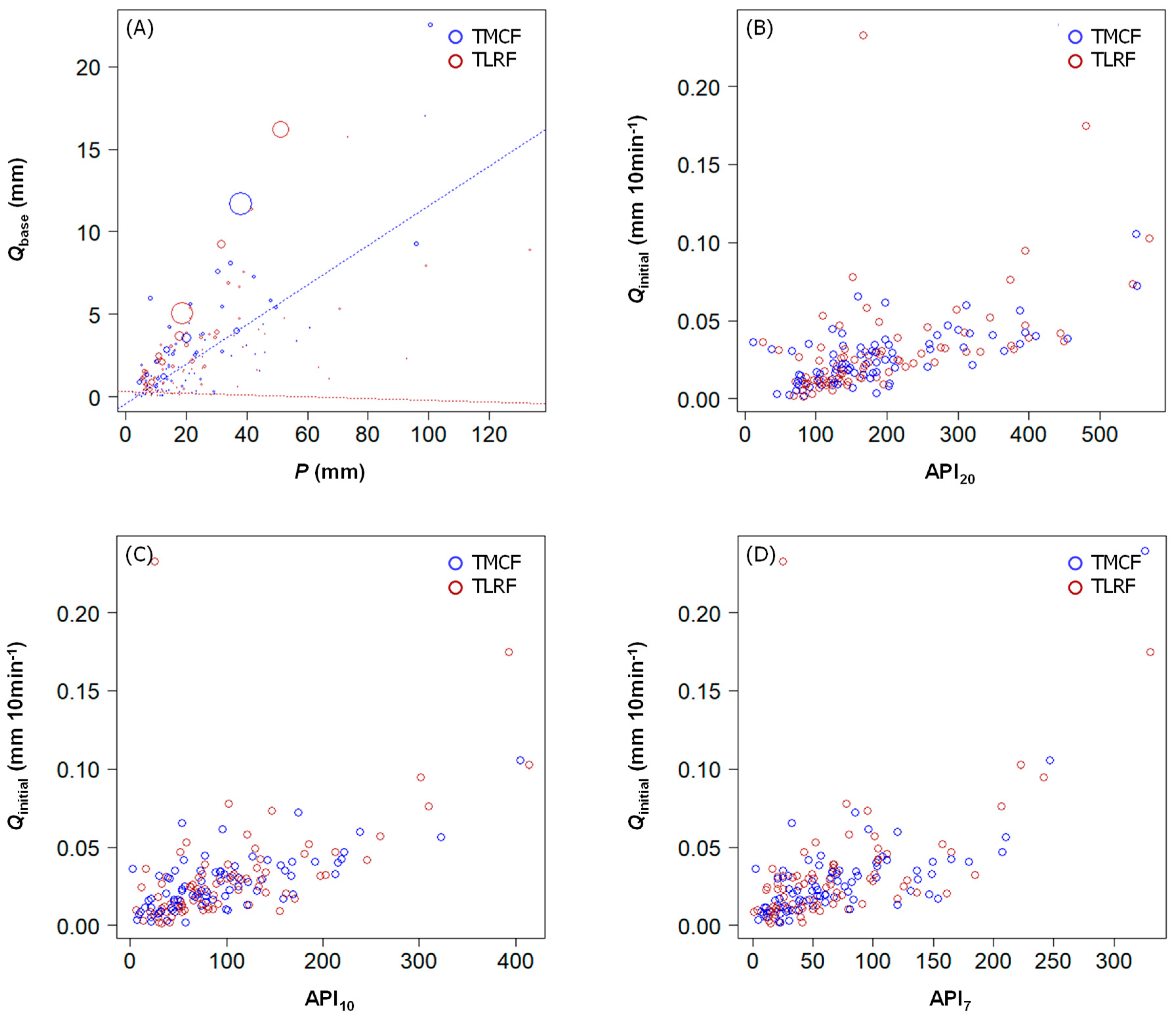
| Slope(°) | Inobong | Alab | ||
|---|---|---|---|---|
| Area (ha) | Area (%) | Area (ha) | Area (%) | |
| ≤10 | 0.11 | 2.56 | 0.47 | 5.52 |
| 11–20 | 0.86 | 20.00 | 1.35 | 15.84 |
| 21–30 | 2.54 | 59.07 | 3.85 | 45.18 |
| 31–40 | 0.71 | 16.51 | 2.75 | 32.27 |
| 41–50 | 0.08 | 1.86 | 0.1 | 1.17 |
| ≥50 | 0 | 0.00 | 0.002 | 0.02 |
| Species (TMCF, Mt. Alab) | Count (Stem ha−1) | Total BA (m2 ha−1) | Rel. Tree Density (%) | Rel. BA (%) | Rel. Dominance (%) |
|---|---|---|---|---|---|
| Dacrydium xanthandrum | 120 | 11.03 | 0.47 | 35.00 | 17.73 |
| Leptospermum flavescens | 80 | 8.58 | 0.31 | 27.22 | 13.77 |
| Adinandra acuminata | 40 | 2.64 | 0.16 | 8.36 | 4.26 |
| Lithocarpus bullatus | 40 | 1.52 | 0.16 | 4.83 | 2.49 |
| Litsea cylindrocarpa | 280 | 1.33 | 1.10 | 4.23 | 2.66 |
| Myrsine sp. | 240 | 1.15 | 0.94 | 3.65 | 2.30 |
| Tristaniopsis cf.obovata | 960 | 0.66 | 3.76 | 2.08 | 2.92 |
| Adinandra sp. | 80 | 0.30 | 0.31 | 0.95 | 0.63 |
| Magnolia carsonii | 240 | 0.27 | 0.94 | 0.85 | 0.90 |
| Melastoma sabahense | 200 | 0.22 | 0.78 | 0.69 | 0.74 |
| Species (TLRF, Inobong) | Count (Stem ha−1) | Total BA (m2 ha−1) | Rel. Tree Density(%) | Rel. BA (%) | Rel. Dominance (%) |
| Crypteronia paniculata | 8 | 4.54 | 0.49 | 17.44 | 8.97 |
| Mallotus paniculatus | 208 | 2.49 | 12.78 | 9.56 | 11.17 |
| Ixonanthes reticulata | 4 | 1.83 | 0.25 | 7.04 | 3.64 |
| Eugenia napiformis | 12 | 1.39 | 0.74 | 5.34 | 3.04 |
| Macaranga triloba | 172 | 1.31 | 10.57 | 5.04 | 7.80 |
| Macaranga gigantea | 88 | 1.29 | 5.41 | 4.95 | 5.18 |
| Sandoricum koetjape | 4 | 1.24 | 0.25 | 4.75 | 2.50 |
| Macaranga pearsonii | 84 | 0.92 | 5.16 | 3.54 | 4.35 |
| Litsea sp. | 24 | 0.87 | 1.47 | 3.33 | 2.40 |
| Metadina trichotoma | 4 | 0.61 | 0.25 | 2.33 | 1.29 |
| Hydro. Component | Metric | From Data | Difference (%) | |
|---|---|---|---|---|
| TLRF | TMCF | |||
| Storm runoff | ||||
| Runoff | Qtot (mm) | 306.714 | 825.986 | 169.30 |
| Qstorm (mm) | 117.995 | 568.434 | 381.75 | |
| Responsiveness | Qpeak (mm 10 min−1) | 0.132 | 0.996 | 657.11 |
| Tres (mins) | 23.288 | 80.769 | 246.83 | |
| Tpeak (mins) | 90.137 | 172.637 | 91.53 | |
| Baseflow | Qinitial (mm 10 min−1) | 0.026 | 0.033 | 26.96 |
| Qbase (mm) | 190.640 | 260.592 | 36.69 | |
| Stormflow duration | Tstorm (mins) | 768.356 | 927.143 | 20.67 |
| Rainfall | ||||
| Rainfall | P (mm) | 2083.500 | 1893.000 | −9.14 |
| Mean rain intensity | Pi (mm min−1) | 16.604 | 10.008 | −39.73 |
| Antecedent precipitation | API1 | 12.541 | 9.846 | −21.49 |
| API3 | 35.253 | 27.725 | −21.35 | |
| API5 | 56.596 | 42.577 | −24.77 | |
| API7 | 83.432 | 58.258 | −30.17 | |
| API10 | 117.610 | 82.769 | −29.62 | |
| API15 | 175.349 | 127.396 | −27.35 | |
| API20 | 228.705 | 163.016 | −28.72 | |
| Y | TLRF (Inobong) | TMCF (Alab) | GLM Type | AIC | R2 adj. | p | ||||||||||
|---|---|---|---|---|---|---|---|---|---|---|---|---|---|---|---|---|
| P | Pi | P·Pi | ante | P·ante | P | Pi | P·Pi | ante | P·ante | |||||||
| a | b | c | d | e | f | a + a2 | b + b2 | c + c2 | d + d2 | e + e2 | f + f2 | |||||
| Qtot | −0.177 | 0.040 | 0.153 | 0.066 | Gam-log | 752.88 | 0.907 | <0.05 | ||||||||
| Qstorm | −3.253 | 0.088 | 0.062 | −0.001 | −1.316 | 0.087 | Gam-log | 407.51 | 0.820 | <0.05 | ||||||
| Qbase | 0.044 | 0.069 | 2.647 i | 1.279 | Gaus-iden | 709.47 | 0.624 | <0.05 | ||||||||
| Qinitial | −5.235 | 0.006 20 | −4.159 | 0.004 | Gam-log | −940.97 | 0.935 | <0.05 | ||||||||
| Qpeak | −3.376 | 0.026 | 0.015 | −3.047 | 0.079 | 0.016 | Gam-log | −235.94 | 0.751 | <0.05 | ||||||
| Qpeakadj | −4.429 | 0.036 | 0.032 | −3.412 | 0.088 | 0.015 | Gam-log | −333.41 | 0.714 | >0.05 | ||||||
| Tstorm | 50.027 | 22.008 | −971.53 i | 182.246 | 41.763 | 46.231 | −236.605 i | −151.82 | Gam-iden | 2394.8 | 0.579 | <0.05 | ||||
| Tpeak | −11.893 | 6.109 | 0.205 15 | −0.017 | 47.344 | Gam-iden | 1869.1 | 0.341 | <0.05 | |||||||
| Tres | 0.018 | Gam-inv | 578.49 | - | <0.05 | |||||||||||
| Qinitial | −4.510 | 0.00610 | −4.017 | Gam-log | −920.23 | 0.926 | >0.05 | |||||||||
| Qinitial | −4.409 | 0.0087 | −3.983 | Gam-log | −914.48 | 0.924 | >0.05 | |||||||||
| Tpeak | 4.380 | 0.026 | −0.052 | 0.00003 | 4.974 | 0.035 | −0.122 | 0.001 | Gam-log | 1734.6 | 0.999 | <0.05 | ||||
| Tres | 26.049 | −0.170 | 100.741 | −1.825 | Gam-iden | 571.53 | 0.023 | <0.05 | ||||||||
| Hydro. Component | Metric | Computed from GLM | Difference (%) | |
|---|---|---|---|---|
| TLRF | TMCF | |||
| Storm runoff | ||||
| Runoff | Qtot (mm) | 70.419 | 138.861 | 97.19 |
| Qstorm (mm) | −23.627 | 76.086 | 422.04 | |
| Responsiveness | Qpeak (mm 10 min−1) | −2.385 | −1.244 | 47.86 |
| Tres (mins) | 23.226 | 62.777 | 170.28 | |
| Tpeak (mins) | 112.649 | 153.629 | 36.38 | |
| Baseflow | Qinitial (mm 10 min−1) | −3.863 | −3.507 | 9.21 |
| Qbase (mm) | 224.247 | 228.582 | 1.93 | |
| Stormflow duration | Tstorm (mins) | 793.509 | 883.500 | 11.34 |
Publisher’s Note: MDPI stays neutral with regard to jurisdictional claims in published maps and institutional affiliations. |
© 2022 by the authors. Licensee MDPI, Basel, Switzerland. This article is an open access article distributed under the terms and conditions of the Creative Commons Attribution (CC BY) license (https://creativecommons.org/licenses/by/4.0/).
Share and Cite
Nainar, A.; Mahali, M.; Kamlun, K.U.; Besar, N.A.; Majuakim, L.; Justine, V.T.; Cleophas, F.; Bidin, K.; Kuraji, K. Higher Water Yield but No Evidence of Higher Flashiness in Tropical Montane Cloud Forest (TMCF) Headwater Streams. Hydrology 2022, 9, 162. https://doi.org/10.3390/hydrology9100162
Nainar A, Mahali M, Kamlun KU, Besar NA, Majuakim L, Justine VT, Cleophas F, Bidin K, Kuraji K. Higher Water Yield but No Evidence of Higher Flashiness in Tropical Montane Cloud Forest (TMCF) Headwater Streams. Hydrology. 2022; 9(10):162. https://doi.org/10.3390/hydrology9100162
Chicago/Turabian StyleNainar, Anand, Maznah Mahali, Kamlisa Uni Kamlun, Normah Awang Besar, Luiza Majuakim, Vanielie Terrence Justine, Fera Cleophas, Kawi Bidin, and Koichiro Kuraji. 2022. "Higher Water Yield but No Evidence of Higher Flashiness in Tropical Montane Cloud Forest (TMCF) Headwater Streams" Hydrology 9, no. 10: 162. https://doi.org/10.3390/hydrology9100162
APA StyleNainar, A., Mahali, M., Kamlun, K. U., Besar, N. A., Majuakim, L., Justine, V. T., Cleophas, F., Bidin, K., & Kuraji, K. (2022). Higher Water Yield but No Evidence of Higher Flashiness in Tropical Montane Cloud Forest (TMCF) Headwater Streams. Hydrology, 9(10), 162. https://doi.org/10.3390/hydrology9100162






